MAKING THE JOURNEY TO RADAUTZ, ROMANIA
“SEARCHING FOR PESSIE SCHIMMEL”
MARCH 2005
BACKGROUND
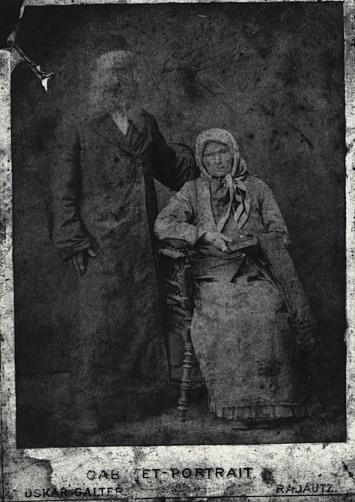 |
The Oskar Galter photograph of the "cousins getting ready to go to Palestine." |
I had always known that my parents were born in Vienna and my grandparents lived there before them. Further back than that, I had really never asked what the history of the family was although I knew that my father’s family originally came to Vienna from Galicia in the late 1880s. A few years ago, my mother showed me an old photograph from her side of the family, probably around 1900. The photograph showed some people in their middle years, well dressed, with an inscription on the bottom that said “Oskar Galter”( the photographer) and “Radautz”. My mother remembered that her grandmother Pessie had told her that the “people in the picture” were “cousins getting ready to go to Palestine”. Thus began the search that culminated in my recent trip to Radautz, a prominent town in an area known in history as Bukowina, now straddling the Romanian and Ukrainian border.
At the suggestion of Bruce Reisch, I had engaged Ladislau Gyemant to conduct some basic research. He researched the records in Suceava and found the marriage record of my great-grandfather Rachmiel Schimmel son of Jankel and Sara Schimmel of Radautz to Pessie Balaban daughter of Shloime and Rifka Balaban of Botosani. The marriage took place on April 12, 1875, they were both 24 years old. The Schimmels lived at House #1388. Also found was the birth of two of their children in 1878 and 1879. However, he did not find record of the birth of my grandmother in 1888 and we know that sometime in the 1880s the family began to move westward finally ending up in Vienna. The first record of their life in Vienna is at a residence in 1906, but they could have been there prior to that. I have guessed from other information that they may have lived in Sighet, Romania for a number of years. But that is another story.
 |
Pessie Schimmel with grandchildren in Vienna, 1920. The author's mother is standing in front of her. |
While Rachmiel died in 1922 and Pessie moved to Belgrade in 1938 with one of her daughters after Hitler took over Austria. She was killed by the Nazis at the Sajmiste camp outside of Belgrade in 1944. My parents came to the US in 1938, my mother’s parents to England in 1939, my father’s parents were killed in Sobibor in May 1942.
SETTING UP THE TRIP
When I discovered the photograph, I “googled” the name Oskar Galter and Radautz, but found nothing. Then I tried Photographer and Radautz and thus began a relationship via Email and MSN IM with Mihai Colibaba, Freelance Studios in Radautz. As the time went by, I realized his excellent command of English, and his genuine interest in what I was trying to accomplish would be invaluable to me when I went to Radautz. In addition, my mother’s 90th birthday was coming up and I wanted to do something special in honor of that. As it turned out I was able to arrange my first day in Radautz on her birthday, March 8th.
At the advice of a number of people I booked a reservation at the Fast Hotel in Radautz, and as it turned out I had a very nice room with private bath and shower. My itinerary took me on Continental from Newark on Sunday evening March 6th, thru Zurich the next morning, connecting to Swiss Air into Bucharest for a 1PM arrival. I was able to pre-book a driver to pick me up at the airport and take me on a brief tour of the city before my 4:40PM train departure. The service was BeyondTheForest, it was an excellent choice for a non-hassled transfer. While I had been concerned about the train trip to Suceava, the first class accommodations were excellent, the bathroom was clean, and the attendant was helpful. I arrived at Suceava Nord station at 10:15 PM on Monday, just about 24 hours travel time from Newark. I was very happy to see my friend Mihai Colibaba and his father, as my greeting party at the station. The trip to Radautz was a brief 30 mins.
I had booked the return trip for Thursday March 10th, the first class sleeper which leaves Suceava Nord at 11:45 PM and arrives in Bucharest at 6AM. This was one of the finest sleeping compartments I have ever had on a train trip.
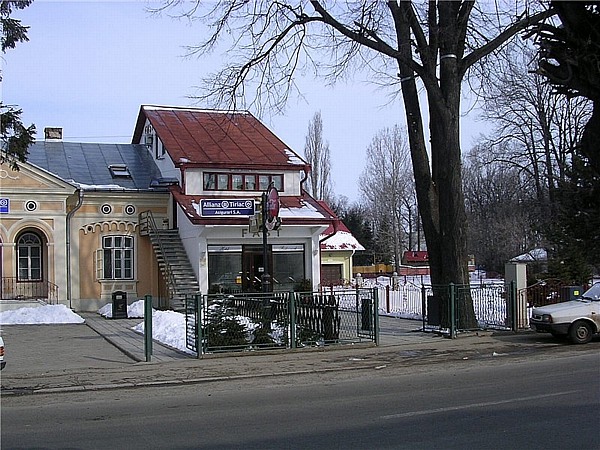 |
 |
The Fast Hotel in Radauti, Romania. |
Peter Linder with Prof. Tania Grinberg of the Radauti Jewish Community Office. |
RADAUTZ
I had asked Mihai to pick me up at the Hotel late Tuesday morning, he had some personal business to attend to and I thought I might sleep late. But I woke at 9AM, full of energy and ready to go. After a great breakfast at the hotel and a quick shot on the internet to send Email home, I started to explore on my own. It was a bright sunny day, snow on the ground, very cold and windy, but I had been checking on the weather and I knew to dress warm.
The hotel is about 1/2 km from town center. Almost immediately I was presented with a photo op as a horse drawn wagon passed the hotel. While there are many cars in town, in the countryside I was to see many of the typical Bukowina horse drawn carts.
I went down a few side streets and saw a cemetery that was bisected by the railroad line, a few homes that still had a water well outside, and a bustling small town with great pastries in sidewalk kiosks. I do not speak Romanian but I memorized such important lines as “I don’t understand”, “does anyone here speak English”, and the like. I was proud of myself when I was able to by a CD for my 12 year old daughter, rap and hip-hop, all in Romanian, so it wasn’t necessary to listen to it in order to check for inappropriate language.
Mihai joined me around noon and we went to meet with Tania Grinberg of the Jewish Community Office . We spoke for a while and she showed me a listing of 3 graves that had the family name Schimmel that Tania had researched before my arrival. These were from the early 1900s, graves before that are hard to find because the lettering may be worn thin by the weather, and Tania said that they are written in Hebrew and hard to read. I was very appreciative of her assistance in this regard. She arranged for a tour of the Temple, and that was a beautiful experience. I was able to imagine my family in this environment, although I knew there were 20 or so synagogues in town before WWII. I was disappointed that I had not arranged my trip to cover a Shabbat, they are always short a man for the required minyan. Not being able to step in as the 10th man really affected me but there was nothing I could do about the travel arrangements I had already made.
As I was to do repeatedly over the next few days, I showed anyone that I met the old original photograph, but it was too far in the past for anyone to identify, and, the community was devastated by the Nazis, not much in the way of old personal effects remained.
As we left the Temple we ran into a gentleman who asked our guide who we were. He then introduced himself as Beno Usher and I remembered the name from an Email exchange with Miriam Taylor. He insisted that we come to his home for some and coffee. He told me a little of his life, he was a survivor of Transnistria, was actually Bar Mitzvah during that time, and had been practicing dentistry in Radautz for 50 years. I was happy to meet him; I am always concerned about a filling falling out on a trip, now I was covered.
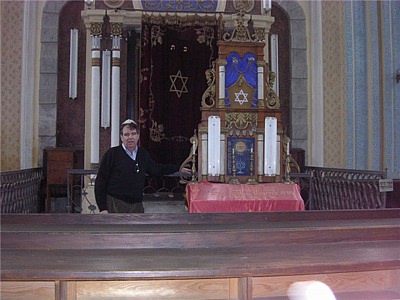 |
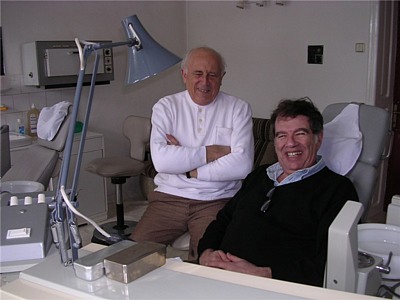 |
Inside the Great Temple in Radautz. |
Visiting with Dr. Beno Usher of Radautz. |
We were to return to Dr. Usher’s home on a second occasion to say goodbye on Thursday. That time while he served us wine, coffee, and cookies, he worked on two patients, and spoke with us while the sound system played “My Yiddish Mama”. We became friends in the short time we were together. He did not speak English, I did not speak Yiddish or Romanian, but Mihai did a marvelous job in the translation of a 2 hour conversation on a wide range of topics. That evening Mihai and I had dinner at a very nice Italian restaurant in town.
Wednesday morning we went to the Town Hall to try our hand at some record research. The Records Director appeared a little reluctant to help at first, Mihai told me that the formal procedure was to apply in writing and it would take 30 days for the request to be approved. I think it was also because there were quite a few other local residents filling out various forms, it was quite a busy office. Adding to the tension is my bad habit of walking into a government office in an overly assertive manner and giving off vibes that say that I require immediate attention.
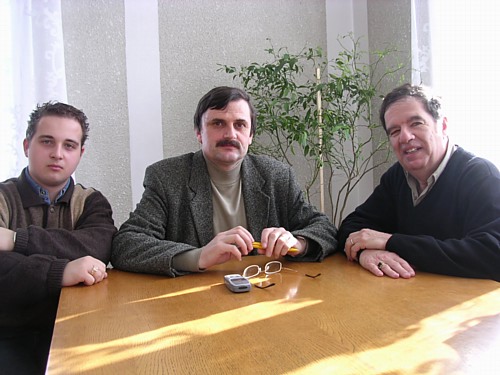 |
The author (right) with Mihai Colibaba (left) and the Vice-Mayor of Radauti, Romania, center. |
We left and Mihai took me into the office of the Public Relations person for the town, we had some coffee, and she suggested that I might like to meet the Vice-Mayor. I agreed and was ushered into his office for more coffee, and some questioning on why I came here in winter when the flowers are so beautiful in the summer. When we returned to the records office the mood had changed, whether because we met the Vice-Mayor or maybe because he was not distracted by other business. Come back in the morning and I will take care of you. I did not need the translation to understand that he was going to be helpful.
Later Wednesday morning I hired a car with a driver, actually the brother of one of the hotel staff, and Mihai and I set out for the surrounding countryside. The roads were snow and ice covered, and the wind was howling across the open plains outside of Radautz as we made our way to the town of Botosani, 80 km from Radautz. We had made contact with the Botosani Jewish community via telephone the prior evening.
After wandering around town asking any of a number of people for directions, we found the office. David welcomed us into the office and showed us death records from 1890 on. I knew that my great-great grandparents lived there, but I had no clue when they died. But David began painstakingly to review the records line by line looking for the first names. It was only then that I saw that many of the late 1800s records read like Jankel sin David, no last names, although the Jews had taken last names officially by then. What an impossible task, which I called off after 30 minutes with many thanks and a donation. I did inquire about the family name Balaban, was it a Jewish name I asked? I was told that here in this part of Romania many Jews had Romanian names.
Back into the car I instructed the driver to go north to the town of Mihaileni on the Ukrainian border, near Siret. Although my great-grandmother’s marriage record said that she was from Botosani, later records from Vienna stated that she had listed her actual birthplace as Mihaileni. The town typifies the term small, we passed thru it in a blink of an eye that we had to back up to take a picture of my pointing at the road sign as proof that I had been there. Later in my trip, when I went to Vienna, I had taken pictures of three apartments where my great-grandparents Pessie and Rachmiel Schimmel lived . Between Mihaileni, ( and we now know they went to Galatz on the Danube in the early 1860s), Botosani , Radautz, Vienna, and then Belgrade, the trip took on the nom de gare of “Searching for Pessie Schimmel”.
 |
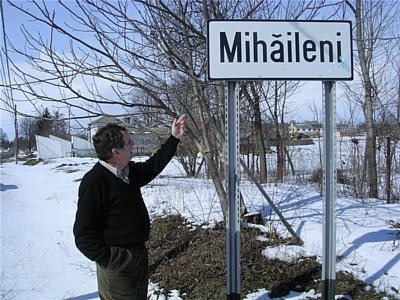 |
Visiting the Botosani, Romania, Jewish Community Office. |
Mihaileni, the birthplace of Pessie Schimmel. |
Upon the return to Radautz that afternoon, I decided to visit the Jewish cemetery. Actually, on the prior morning in Radautz, while I was having breakfast in the hotel, a gentleman came to see me. Given the language barrier, and that nobody in the hotel was able to translate, I had no idea what he wanted. Then he pulled out of his pocket a letter that I had sent to him a month before asking for his help. He was Constantin Popescu, caretaker of the Jewish cemetery. I had sent a number of letters in advance of my trip to various people I wanted to see.
Anyway, Wednesday afternoon Popescu took us to the cemetery, unmarked on the main road, then down a muddy country road, where he unlocked the old wooden door and let us in. 7000 graves occupy the cemetery, many of the older ones are not readable. I found an early 1900s grave which may be a family member and I used that as a proxy for all the gravesites and said Kaddish. Then came a moment I will not soon forget.
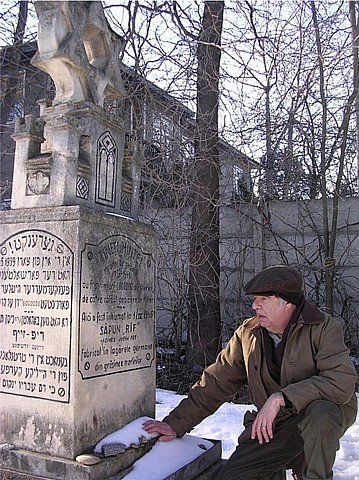 |
The Radauti Holocaust Memorial at the Jewish Cemetery. |
Popescu asked Mihai whether I would like to see the memorial to Jews killed in the war. I looked around for some impressive structure that usually marks a Holocaust memorial. What I was shown was a simple grave marker, mixed in a row amongst other graves. The inscription was in Hebrew and Romanian so I asked Mihai to translate. Paraphrasing, here is what it said. “ A memorial to the 6,000,000 Jews murdered by Hitler’s henchman”…”Buried here in a box is a bar of soap, made from “Juden Fet”( no translation needed here) and “ manufactured in Germany”. I was so mentally exhausted from the past few days, this just did me in, and I sat down in the snow at the foot of the memorial and closed my eyes for a while.
After a much needed nap at the hotel, I went to Mihai’s apartment where I sent some Emails made some calls to the States. Mihai had been following me for past two days taking video of my wanderings while I took digital photos on my own. He intends to make a film paying homage to history of the town, while highlighting portions of my “pilgrimage”. Needless-to-say, I was thrilled with the prospect. What a good friend. He is a very bright young man and really knows how to handle himself in many different situations. We went to a great Romanian restaurant for dinner across from the church on the main street.
Thursday morning I woke up feeling a bit down that this was my last day. I feel that there was so much more I could have done, but time was moving too fast. I would have liked to search the countryside for “The sign of the Schimmel horse” since I had heard that was the origin of the Schimmel name and that the schimmel grey line was known to have been raised in Bukowina. Maybe Mihai will have some luck at that at a later date.
We did return to the Records Office early Thursday morning. The birth records in Radautz are listed alphabetically by family name in a journal which gives the names, year of birth, and record book and page of the original record. The actual records are available in Radautz for the years 1884 onward. The Director set me up with a table and gave me the record books and allowed me all the time I needed. I copied all the Schimmel records, found some that I have some suspicion are close in relations, saw the journal entry for my great aunts birth records that I had, but did not find any record of the birth of my grandmother Ida Schimmel in Radautz. Non-the-less I was thrilled to just look thru the record books and know that my family was walking the streets of the town in the mid 1800s as these births were being recorded. The records are all in German.
After the records office visit, I decided to slow down the pace on this last day and walk around town, say goodbye to Beno and pay my respects to Bondy Stenzler’s father who lives quite close to the Fast Hotel. I took the opportunity to ask him whether he knew where house #1388 might have been. He was the first one to actually shed some light on this mystery. I think he tried to tell me that it was a lot number more than a street address, but the actual location was lost to time.
I think I was just too tired and emotionally drained to do much more searching. A final session with Mihai where he conducted a one hour interview for the video and then we went for a leisurely dinner at the Fast Hotel before my overnight train and trip the next day to Vienna for more searching for family homes and walking thru cemeteries.
A REFLECTION
I had originally thought that this trip might be filled with new discoveries of information. Wow, there is House #1388 where the Schimmels lived; now I have in my hands my grandmother’s missing birth record; and I clearly see the inscriptions on the graves of my great–great-grandparents.
But it is very fitting that none of this came about, that none of this seemingly important detail dared to detract from the spiritual meaning of this trip. I went back and did my duty to past generations to remember forever their names and to understand the diverse cultures that make up my life today.
And now I know for sure that the identities of the “people in the photograph” will never be revealed.
I thought that this trip would allow me to bring to a conclusion my search for family roots in Bukowina. I thought, let someone else pickup from where I have left off. Something makes me think that this process does not end that easily.
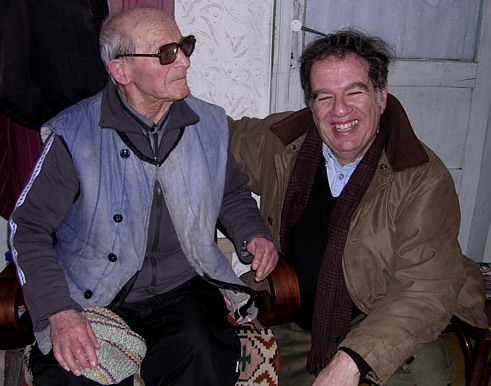 |
Osias (Shike) Stenzler of Radautz (left) with Peter Linder. |
Return to Radauti ShtetLinks Web Site | JewishGen Home Page
